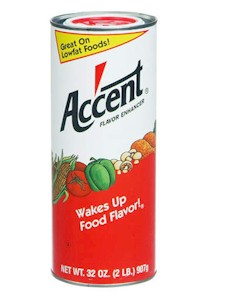Mono-sodium-glutamate (MSG) – the cause of “Chinese Restaurant Syndrome.” It turns out this syndrome is a myth.
HISTORY OF THE MYTH:
The syndrome was first reported in a letter to The New England Journal of Medicine in April of 1968. A physician wrote that he developed a syndrome which he thought might be associated with salt or MSG, and asked the medical community to respond to this syndrome. He described the symptoms as “ numbness at the back of the neck, gradually radiating to both arms and the back, general weakness and palpitation.” He said several of his friends had it also. He speculated that it might be the cooking wine, or the soy sauce- although the restaurant he went to used the same brand of soy sauce he used. He also noted his friends suggested it might be the seasoning of MSG used by the restaurant. (1) The next month ten letters responded – one didn’t think it was MSG, one noted it didn’t happen in all Chinese restaurants – and might be placebo, and another reported a patient developing a stroke after eating the food. The media picked up the new disease “Chinese Restaurant Syndrome” and it became a food-type allergy. Ten months later the journal Science reported that Monosodium L-glutamate “is the cause of the Chinese restaurant syndrome and can precipitate headaches.” (2) The report in Science, was written by one of the people who wrote the letter back to NEJM that May, Dr. Schaumburg. In fact, a later one of his letters was initially done in great humor, “ With the enthusiastic co-operation of the Shanghai Cafe one of us ate Chinese food for breakfast, lunch and dinner until the search had been narrowed to either hot and sour soup or wonton soup, both of which produced the reaction. A rough filtrate of wonton soup also produced the reaction. Upon sampling of the individual ingredients, the dagger of suspicion pointed at monosodium glutamate. Further experiments confirmed this suspicion. The experiments were performed with the use of approved blind and double-blind technics on three volunteers. If the suspicion that irresponsible human experimentation was done has crossed your mind, be at ease. The days of Walter Reed are not past.” (3)

My mother had this in her kitchen. Pure MSG – it made food taste a lot better
The MSG Follow Up Research
Forty years after that original letter, and in spite of years of trials, and clinical trials, it was finally put to rest that “so-called ‘Chinese restaurant syndrome’ and in eliciting asthmatic bronchospasm, urticaria, angio-oedema, and rhinitis. Despite concerns raised by early reports, decades of research have failed to demonstrate a clear and consistent relationship between MSG ingestion and the development of these conditions.” (4)
In spite of good clinical data putting this myth to rest, there will be plenty of people whose confirmation bias tells them they cannot eat in Chinese Restaurants, and will blame MSG, all the while not realizing that without MSG their bodies would cease to function, and that there is more MSG in the Italian food they prefer, than the Chinese food they shun. In test after test, MSG was not any worse than the placebo given in random studies.
In 2011 the Food and Drug Administration’s committee on GRAS (Generally Recognized as Safe) substances stated this: ” There is no evidence in the available information on L-glutamic acid, L-glutamic acid hydrochloride, monosodium L-glutamate, monoammonium L-glutamate, and monopotassium L-glutamate that demonstrates, or suggests reasonable grounds to suspects, a hazard to the public when they are used at levels that are now current and in the manner now practices. However, it is not possible to determine, without additional data, whether a significant increase in consumption would constitute a dietary hazard.” Much like salt, too much isn’t a good thing. (5)
Why MSG is so Important to you
Proteins are made up of molecules of amino acids – some of those amino acids our body can manufacture (they are called non-essential because we do not need to get them from our diet) and some amino acids we must obtain from our diet (called essential amino acids). Glutamic acid, and its form MSG, is a non-essential amino acid – meaning, our body produces glutamate and uses it to build the proteins we need. Without MSG you would be unable to build proteins, run the metabolism your body needs– without this amino acid you would not exist.While glutamic acid is present in every food that contains protein, umami can only be tasted when it is separated from the protein – and functions as an individual amino acid.
MSG – It is one of the tastes you perceive
Before MSG was known for “Chinese Restaurant syndrome” it was used for the flavor it produced, to enhance food. MSG produces a distinct savory flavor that is called Umami. MSG is a common additive in China- while visiting you would see it used almost as we would use salt here. In the United States MSG was sold under the name “Accent.”

In every market in China, such as here in Xi’an, one of the common flavors added to foods is MSG
We have discovered that humans have taste buds for Glutamic acid (MSG). That flavor, umami, or savory (meat-like) stimulates specific receptors located in taste buds, and is now recognized as one of the five basic tastes in addition to sweet, salty, sour, and bitter. MSG is found in many foods, especially in parmesan cheese, tomatoes, soy sauce. One would think if MSG was a real problem there would be an “Italian Restaurant Syndrome.”
There is no one region of the tongue that tastes sour, salt, bitter, sweet, or umami. You may have seen “tongue” maps that show this, it turns out that the taste buds are distributed throughout the tongue. The entire tongue, has taste buds throughout – as well as the intestine (but that is for another blog).
Balance of flavor
If you ever eat something that is too salty, you want to balance it with sweetness – why we love dessert. But umami, that savory taste is why we love the balance in Italian cooking. We add Romano cheese to noodles to enhance the “flavor” – romano is filled with umami. America is in love with ketchup, and tomatoes provide that unique umami flavor. In Japan, instead of adding Romano or Parmesan to their noodles, they are judged by dashi – a broth that is made with seaweed (kombu) that has lots of MSG (and where some of the original MSG was derived from).
While in China, our favorite places to eat were on the streets – and beside almost every wok was a bowl of MSG – used to liberally season the foods, much like we use salt here. Street food in China is among the best food you can get. Some have even suggested that the balance of flavor that umami provides is one reason the Chinese are not subject to obesity (more about that later).
In Australia and the United Kingdom Vegemite and Marmite are all MSG or glutamate based – and all an essential part of that culture.
We are born to appreciate that flavor- human breast milk has almost 3o times higher glutamate than cow’s milk.
In my home state of Alaska, we prefer oysters, clams, and crabs when harvested in February through March – and it turns out they have their highest level of glutamates then. One would think that the Bering Sea would be better to harvest in the tranquil months of summer, but in August the lowest levels of glutamate are then, and Natives will tell you there just isn’t the flavor of the crab that you would like.

August is great in Alaska to see whales, but not great for getting oysters, clams, or crab – the MSG levels are too low and they have less flavor
If you have an imbalance in flavor, then you compensate. Umami, it has been suggested, would provide a better balance if used more in foods. In other words, the emphasis on fat, sweet, and salty has led to some of the obesity, had there been more emphasis on umami, less food would be consumed, because there would be more of a balance. (6)
MSG and Obesity:
Apparently this “non essential” amino acid is now being blamed for obesity and short stature. As you can see by reference (6) MSG can be used to help regulate appetite. Then came a paper in 2011 (7) claiming to show a correlation between MSG and obesity. Sadly- this was one of the most poorly written papers, and was taken apart for multiple flaws in (7). To quote them: ”
Finally, even though observational studies often provide useful information for hypothesis formulation, given the significant questions and concerns raised in this study, it is premature to even generate a plausible hypothesis on MSG intake and obesity.
The current epidemic of obesity is worldwide, including in Asia. Because MSG has been extensively used as a flavoring agent in Asia, it could also potentially play an important role of enhancing palatability and acceptability of calorie-reduced diets. Until further confirmatory information becomes available, extreme caution needs to be exercised not to raise undue public safety concerns regarding MSG consumption.”
:
(1) Chinese-Restaurant Syndrome. Kwok, RHM. N Engl J Med 1968; 278:796April 4, 1968 (Letter to the editor)
(2) Monosodium L-glutamate: its pharmacology and role in the Chinese restaurant syndrome. Schaumburg HH, Byck R, Gerstl R, Mashman JH. Science. 1969 Feb 21;163(3869):826-8.PMID: 5764480
(3) Sin Cib Syn: Accent on Glutamate. Schaumburg HH, Byck R, N Engl J Med 1968; 279:105-106July 11, 1968 (Letter to the editor)
(4) Monosodium glutamate ‘allergy’: menace or myth?Williams AN, Woessner KM.Clin Exp Allergy. 2009 May;39(5):640-6. PMID: 19389112
(5) From the US Food and Drug Administration GRAS database.
(6) Umami flavour as a means of regulating food intake and improving nutrition and health. Mouritsen OG. Health. 2012 Jan;21(1):56-75. PMID: 22544776
(7)↵ He K, Du S, Xun P, Sharma S, Wang H, Zhai F, Popkin B. Consumption of monosodium glutamate in relation to incidence of overweight in Chinese adults: China Health and Nutrition Survey (CHNS). Am J Clin Nutr 2011;93:1328–36.
(8)A lack of epidemiologic evidence to link consumption of monosodium L-glutamate and obesity in China.vBursey RG, Watson L, Smriga M.Am J Clin Nutr. 2011 Sep;94(3):958-60; author reply 960-1. doi: 10.3945/ajcn.111.020727.
